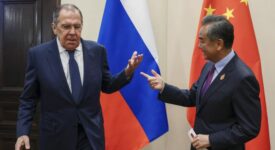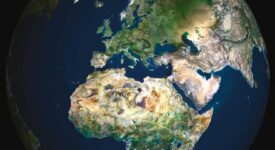Disappearing Arctic ice and thawing permafrost are making international headlines alongside burning forests. Moreover, increased international attention is currently focused on the Arctic because of China’s regional interests, Russia’s militarisation efforts, tweets from a particularly polarising US President and controversial statements by his Secretary of State. These Arctic changes have ripple effects on Europe, be it rising sea levels, coastal flooding, changing weather patterns, or through the significance of regional economic changes.
What should the European Union do about these developments? Is there a need for an update of its Arctic policy? An ambivalent policy of fence-sitting that is currently lacking a long-term perspective, clear goals and necessary financial support mechanisms, the EU’s Arctic approach requires simplification. The EU’s Arctic engagement needs to be future-oriented, with clearly stated goals and an honest assessment of what the EU can and wants to achieve in the Circumpolar North.
For over a decade, the media and some analysts have speculated about possible Arctic economic boom related to resource extraction and shipping opportunities and voiced their anxiety about geopolitical tensions. So far, no actual conflicts have materialised, but the warnings certainly sound more credible in the age of Putin, Trump and Xi Jinping. Russia is indeed building up its military potential in the North. China published its first Arctic policy statement in January 2018, calling itself a ‘near-Arctic state’. And, Chinese-Russian cooperation, especially as regards Arctic natural resources, is gaining momentum.
In May 2019, the US Secretary of State spoke aggressively against Chinese activities in the Arctic and deplored Russian attempts to seize greater control over Arctic maritime traffic. The tone and timing of the speech raised many eyebrows in Arctic policy circles, which are used to a more cordial and cooperative regional tone and to the willingness of great powers to insulate Arctic matters from global tensions. In fact, Arctic cooperation was actually strengthened following the Crimean and East Ukrainian crises, and most recently through the adoption of a fisheries agreement for the Central Arctic Ocean. However, there are concerns US climate denialism may adversely impact the functioning of the Arctic Council.
The perceived shift in Arctic geopolitics and economics led to calls for updating the EU’s Arctic policy and adopting a true EU strategy for the Arctic. We assume that this means that the EU should identify its key interests, adopt a long-term perspective, pronounce clear goals and provide institutional and financial means for their achievement. Can the EU adopt a credible and effective Arctic strategy? What are the EU’s strategic considerations for a region most European citizens only associate with polar bears? In answering these questions, three aspects should be highlighted. First, the Arctic policy is a mixed bag, making policy prioritisation very challenging. Second, there are problems with most of the objectives the EU could adopt for its Arctic policy. Third, the Arctic is actually a marginal topic within the EU.
Everything and Nothing: A Policy With Too Many Elements
Encompassing many issues, sectors and stakeholders, some interlinked, some connected only via an ‘Arctic’ label, being both an internal and external nature, devising an effective Arctic EU policy strategy bringing together these various elements is a structural challenge, with which all Arctic and non-Arctic states struggle, with varied degrees of success. Considering that the EU’s current Arctic policy has issues of an internal nature at its core, particularly the sustainable development of the European Arctic, a future strategy would continue to combine various internal and external elements.
Defining What the EU Wants, Strategically
It is rather challenging to define clear, convincing and credible goals for the EU’s future Arctic engagement. The EU’s Arctic policy itself has no effect on some of the key issues it continuously stresses, while the EU also has little influence or its attempts to use its market power are met with anxiety in the region. First, climate change mitigation – a central ‘priority area’ of the EU’s Arctic policy – is a global issue, not an Arctic-specific one. Second, the EU’s role in maintaining Arctic peace and cooperation is marginal, if only the Union has precious little to do in terms of influencing the relations between Arctic states or the regional actions of global powers such as China. Third, as regards rule-based governance of Arctic resource extraction and navigation, an increased EU involvement usually triggers anger or anxiety among Arctic actors, also from close partners such as Iceland or Norway.
Too Marginal, Too Unknown, Too Boring?
Good information is available and the EU has in fact greatly contributed to production (via research funding) and aggregation (via various assessments and reports) of knowledge about the region. However, the relative marginality of Arctic issues in Brussels means that this information is not necessarily absorbed by all relevant policymakers. If the EU were to adopt a strategy, its objectives would need to be shared by all member states with the need for some coordination between their activities relevant to the Arctic. Could that be effective for a Union of 27 regarding a marginal policy area where the EU has relatively limited influence? Putin, Trump and Xi Jinping are not the Arctic destabilisers the media might communicate them to be. Thus, what should the EU do?
Which Way is North?
The EU does indeed influence many Arctic developments, in particular in the European part of the region. Changes in the Arctic so far are dramatic only in terms of climate change impacts on Arctic environment and livelihoods. EU policymakers should not fall for over-egged geopolitical or economic narratives. However, the region is clearly changing and thus the EU’s Arctic policy may indeed need an update that has to be based on realistic foresights and the acknowledgement of the actual role of the EU in the region and its capability to make a difference. A modest option for Arctic strategy-building could be to agree on a small set of clear sustainable development targets specific for the European Arctic – rather than for the Arctic as a whole – and devise a strategy to implement those targets.
‚Can the EU’s Arctic Policy Find True North?‘ – Briefing Paper by Adam Stepien and Andreas Raspotnik – Centre for European Policy Studies / CEPS.
The Briefing Paper can be downloaded here







